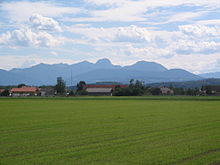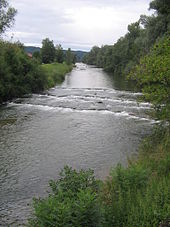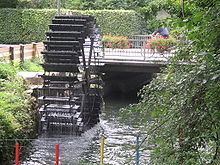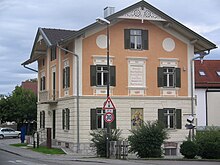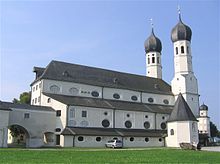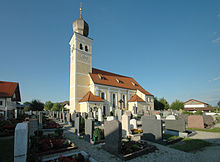Bruckmühl
| coat of arms | Germany map | |
|---|---|---|
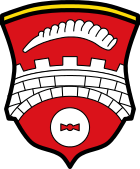
|
Coordinates: 47 ° 53 ' N , 11 ° 55' E |
|
| Basic data | ||
| State : | Bavaria | |
| Administrative region : | Upper Bavaria | |
| County : | Rosenheim | |
| Height : | 511 m above sea level NHN | |
| Area : | 50.21 km 2 | |
| Residents: | 16,606 (Dec. 31, 2019) | |
| Population density : | 331 inhabitants per km 2 | |
| Postal code : | 83052 | |
| Area code : | 08062 | |
| License plate : | RO , AIB , WS | |
| Community key : | 09 1 87 122 | |
| LOCODE : | DE BKM | |
| Market structure: | 45 districts | |
Market administration address : |
Rathausplatz 4 83052 Bruckmühl |
|
| Website : | ||
| First Mayor : | Richard Richter ( CSU / PW ) | |
| Location of the Bruckmühl market in the Rosenheim district | ||
Bruckmühl is a market in the Upper Bavarian district of Rosenheim . The community belongs to the district court district of Rosenheim in the district court district of Traunstein .
geography
Geographical location
Bruckmühl is located in the Mangfall Valley . The Mangfall flows through the place. Neighboring communities are Bad Aibling , Tuntenhausen , Baiern , Feldkirchen-Westerham and Irschenberg . After Rosenheim is 18 km, the junction of the Irschenberg motorway eight nine kilometers and the state capital Munich km 43rd In the municipality of Bruckmühl there are four train stations on the Mangfall Valley Railway .
Community structure
Bruckmühl has 45 districts:
history
Until the 18th century
The area of today's Bruckmühl market in the fertile Mangfall Valley was a settlement long before the turn of the times, as is evidenced by finds from the late Neolithic (around 3000 BC), barrows from the Bronze Age and Celtic high fields (near Unterstaudhausen). Later a Roman road ran through the Mangfall Valley. It is assumed that the places that are called -wiechs (Wiechs, Sonnenwiechs, Noderwiechs) go back to the Latin "Vicus" (dt. Village) and have therefore existed since Roman times. After the end of Roman times, the Bavarians came to the region around the beginning of the 6th century and founded the -ing-denominated places such as Götting and Högling. Row graves from that time have been found in several places in the municipality. In the Middle Ages a small castle complex was built on the Berghamer Leite by the von Holnstain family.
The mill in Bruck is considered to be the first and subsequently eponymous building of Bruckmühl in the narrower sense. The term only describes the location of the building, namely the fact that the mill is on the bridge over the Mangfall.
It is not clear when exactly the mill was built. The first documentary mention, however, can already be found in transfer agreements from 1325 and 1327. The chroniclers assume that the mill was built long before these first documented mentions and that it was of economic importance for the surrounding villages and properties from the start.
Originally the mill in Bruck was probably driven directly by the water of the Mangfall, although it was the oldest and only house on the market on the so-called Mühlbach for a long time. Only in the 17th century was a second house next to the mill.
19th and 20th centuries
Today a mill wheel built in the 1980s reminds of the mill, which is still driven by the mill stream, but only has a symbolic character. An indication of the importance of the mill can still be found today in the coat of arms of the Bruckmühl market, namely the use of a stylized millstone.
In the middle of the 19th century, Bruckmühl consisted of only three houses and belonged to the political community of Kirchdorf. However, the opening of the Holzkirchen – Rosenheim railway on October 31, 1857 led to steady growth in the town. Initially, the railway line was only planned south along the Mangfall, but the landowners resisted and the plan for the railway line had to be renewed. The first railway accident in the community occurred on April 23, 1915. The railway barriers were not closed despite the approaching train. The servant of the Mittenkirchen yodel farmer was supposed to fetch sawdust and walked carelessly across the tracks. The passenger train knocked over the wagon. The farmhand was seriously injured, the horses were killed.
In 1926 the Herz-Jesu-Kirche in Bruckmühl, built through donations, was inaugurated by Cardinal Michael von Faulhaber . The altar was not installed until 1939. In 1929 the community got its own school house. On March 31, 1948, the parish of Kirchdorf am Haunpold was renamed Bruckmühl. The Protestant church was consecrated on October 10, 1954. In 1964 it was raised to the market . During the regional reform in 1972, the municipality of Bruckmühl, which had previously belonged to the Bad Aibling district, was added to the now enlarged Rosenheim district.
Incorporations
On January 1, 1975, the Holzham community voluntarily joined Bruckmühl. The community of Götting was incorporated as part of the regional reform in Bavaria on May 1, 1978.
Population development
Between 1988 and 2018 the market grew from 12,871 to 16,534 by 3,663 inhabitants or by 28.5%.

politics
Market council
24 voluntary councilors together with the full-time mayor form the market council of Bruckmühl.
| 2014 | 2008 | 2002 | |
|---|---|---|---|
| Total seats | 24 | 24 | 24 |
| CSU / PW | 12 | 13 | 16 |
| Green | 4th | 2 | |
| SPD | 3 | 3 | 4th |
| ÜWG | 1 | 3 | 4th |
| OLB 1 | 2 | 3 | |
| BP | 2 | - |
mayor
- 1876–1903: Josef Kleinmaier, Högling
- 1903–1909: Sebastian Stahuber, Högling
- 1909–1933: Georg Huber, Noderwiechs
- 1933–1944: Johann Wöstner, Bergham
- In the post-war year 1945 there were six mayors.
- 1946–1960: Sebastian Grandauer, Maxhofen
- 1960–1966: Johann Scheibmaier, Bruckmühl
- 1966–1971: Vigil Huber, Noderwiechs
- 1971–1993: Karl Puff, Bruckmühl
- 1993–1999: Eduard Bergmüller, Bruckmühl
- 1999–2014: Franz Xaver Heinritzi, Bruckmühl
- since 2014: Richard Richter, Bruckmühl
coat of arms
The name Bruckmühl (formerly Pruckmil) is derived from two essential features of the municipality that are also visible in the coat of arms. It is the stylized bridge (Bruck) and the also recognizable mill wheel (mühl). Both go back to historical events, namely the fact that there was a bridge over the Mangfall at the settlement site of the community early on and this river was used to operate a mill. The fenugreek is borrowed from the noble coat of arms of the Lords of Holnstain. This municipal coat of arms has been used since 1952.
Community partnerships
Bruckmühl maintains a partnership with Bruck an der Leitha in Lower Austria . The town twinning was established on September 13, 1974.
Economy and Infrastructure
The economic area of Bruckmühl was discovered early for the settlement of industrial companies due to its convenient location. The founding of the BWB by Bayerische Wolldeckefabrik Weiler, Bauer & Co., which acquired the factory in 1904 and named it Bayerische Wolldeckefabrik Bruckmühl from 1913 (over 800 employees after the Second World War), had a decisive influence on this development . Until the 1980s, among other things, blankets for the Bundeswehr were produced there. No less important was the settlement of the Heufeld chemical factory , which was founded in 1858, now known as Clariant in Heufeld. Today technical catalysts are manufactured here.
The Leitzachwerk was built between 1911 and 1913. The Mangfall canal was built in 1908; the turbine house in 1911.
The headquarters of the world-famous Salus company , which specializes in herbal medicinal products and teas, is located in the center of the village (where the mill at Bruck used to be) . Not far from there is the Neenah Gessner paper mill (formerly Fibermark Gessner, previously: Steinbeis Gessner), part of the American Neenah Paper group, which is the global market leader with its technical specialty papers and supplies industrial customers on all continents. The location of the Fritzmeier company, which moved into the existing factory building of a cloth factory in Hinrichssegen in 1972, should not go unmentioned.
The Mangfall Center was opened in October 2014. This local supply center houses a discounter, a full-range supplier as well as several smaller shops and a fitness center.
Local public transport
- Rail traffic: Bruckmühl is on the Mangfall Valley Railway (Rosenheim - Holzkirchen railway line) and has four train stations in the municipality, in the districts of Bruckmühl, Heufeldmühle, Heufeld and Hinrichssegen.
- Bus traffic: Bruckmühl is connected to the regional traffic of Upper Bavaria with two bus routes . Lines 9581 and 9582 have connections to Bad Aibling , Feldkirchen-Westerham and Aying .
Established businesses
(Selection)
- Neenah Gessner (specialty papers), formerly FiberMark Gessner
- Organ builder Frenger and Eder Organ builder , until 2015 Frenger & Eder
- Fritzmeier Composite (plastics processing)
- Salus (herbal medicine)
- Clariant AG formerly Süd-Chemie AG (catalysts)
- Kirchdorf thermal power station
education
- Gymnasium Bruckmühl (natural science, technology and language high school), since September 2003
- Holnstainer primary school in Bruckmühl
- Justus von Liebig School in Heufeld
- State secondary school Bruckmühl
- Elementary school Götting (one course, four classes)
- 7 kindergartens
- Adult Education Center Bruckmühl
Other facilities
Retirement home, library, family center, district composting plant, sewage treatment plant, swimming pool, waterworks and waste collection point, Bruckmühl volunteer fire department .
Culture and sights
Museums and Archives
- Gallery Markt Bruckmühl
- Animal Museum
- Folk music archive of the district of Upper Bavaria
Natural monuments
- 1000-year-old linden tree in Högling
Buildings
- In 1860 a villa in the style of historicism was built on the Bruckberg . Oscar Schanzenbach , King Ludwig II's personal physician , had this built for himself. The Neuhaus and von Brück families later lived there. Today the villa belongs to the Greither family. In 1880 the old market fountain from Bad Aibling was brought to the villa. During excavations in the courtyard of Villa Schanzenbach, Roman coins were found.
- In 1956 the new town hall was completed. The inauguration took place on April 22, 1956. In 1983 the north wing was added to the existing building.
- Pilgrimage Church of the Holy Trinity in Weihenlinden, built 1653–1657
- Former parish church of St. Martin in Högling
- 1925–1926 the parish church of the Sacred Heart was built.
- Parish Church of St. Michael in Götting
- Former castle complex (that of Holnstain) in the Bergham district
- Former structure of the Stiegelburg near Unterstaudhausen
- Salus-Auwald-Biotop (nature trail along the Mangfall )
- Parts of the television film Pastor Braun: Brauns Heimkehr were filmed in the Neenah Gessner paper mill .
Buildings by Peter Missoni
The Italian architect Peter Missoni contributed a lot to the development of the community in von Bruckmühl's early years. Buildings like the Gasthaus Thurmaier (today Brückenwirt), the Thurmaier Villa, the Dorrerhaus (today Galerie Markt Bruckmühl), the Stuckenhaus (former monastery of the poor school sisters) and the old rectory were works by Missoni.
He was both an architect and site manager, which is why mainly Italian guest workers were employed in the construction of the stylistically striking buildings. Missoni worked in the tradition of his father, who was also an architect in Bruckmühl.
One of the most interesting buildings by Bruckmühl is probably the Böhmerhaus, which was also designed by Missoni. Jakob Böhmer, the builder of the house, decided to build a very solid house in order to survive the floods of the Mangfall almost undamaged. The house is almost square and shows many elements of the Renaissance style . You can also clearly see the classic form structure. The first floor is very noticeable, because it was decorated very splendidly from the outside. It was also the noble floor (piano nobile). The alternation of the triangular and arched window gables give the house a unique recognition value. The facade under the roof ends with an elaborate attic . At that time there was a royal Bavarian gendarmerie station in the house . The outside of the house was restored a few years ago and is now used as an apartment building.
Regular events
- Folk festival, celebrated annually since 1952. Start: always the second Friday in July. Duration: ten days
- Bruckmühler Radsportnacht, annually from 1991 to 2009. From 2016 again.
- Bruckmühler Bürgerfest in summer, annually since 2011
- Festival of the Bruck Bulls (Sonnenwiechs), annually
Daughters and sons of the church
- Eleonore Baur (1885–1981), National Socialist and personal friend of Adolf Hitler
- Georg Hangl (1889–1945), was murdered by the SS shortly before the end of World War II
- Oskar Kaul (1885–1968), musicology professor in Würzburg
- Robert Lechner (* 1967), racing cyclist
- Michael Niedermeier (* 1990), world champion art cycling
Honorary citizen
- Josef Völkl, (founder of the Waldheim settlement) granted honorary citizenship on November 19, 1951
- Dr. Wilhelm Glasser, (chief physician of the former hospital) honorary citizenship awarded on April 24, 1953
- Director Albert Mayer, (former wool blanket factory) honorary citizenship granted on May 21, 1954
- Pastor Georg Stuhlreiter, honorary citizenship granted on May 27, 1955
- Sebastian Grandauer, former mayor, honorary citizenship granted December 22, 1970
- Hermann Steinbeis, honorary citizenship awarded on December 2, 1976
- Pastor Sebastian Loidl, honorary citizenship awarded July 26, 1979
- Pastor Alois Namberger, honorary citizenship granted on June 23, 1983
- Karl Puff, (Mayor), honorary citizenship granted on April 13, 1994
- Georg Stempfle, (Second Mayor), honorary citizenship awarded on December 18, 1997
- Otto Greither (Salus-Haus), honorary citizenship awarded on December 21, 2000
- Eduard Bergmüller, (Mayor), honorary citizenship awarded on December 21, 2000
- Franz X. Heinritzi, (Mayor), honorary citizenship awarded on December 18, 2014
literature
- Kathrin Müller: The pilgrimage church Weihenlinden. Building design and iconography in a historical context . In: LMU publications, history and art studies. No. 15. Ludwig Maximilian University, Munich 2006 (full text) .
- Helmut Giese: Market Bruckmühl. Pictures from days gone by. Geiger-Verlag, Horb am Neckar 2001, ISBN 3-89570-741-4 .
- Helmut Giese: Bruckmühl and the surrounding area. A home book. Bruckmühl 2006.
- Grietje Suhr, Hubert Fehr: Gold earring and Bavarian sword - Bruckmühl at the end of the Merovingian era. Bruckmühl 2007, ISBN 978-3-00-023425-5 . (Accompanying book to the grave finds 2003 / exhibition 2007.)
Web links
Individual evidence
- ↑ "Data 2" sheet, Statistical Report A1200C 202041 Population of the municipalities, districts and administrative districts 1st quarter 2020 (population based on the 2011 census) ( help ).
- ↑ Mayor 2020 - 2026. Municipality, accessed on May 31, 2020 .
- ↑ Markt Bruckmühl in the local database of the Bayerische Landesbibliothek Online . Bayerische Staatsbibliothek, accessed on September 15, 2018.
- ↑ http://www.bruckmuehl.de/index.php?id=0,26 | Homepage of the Bruckmühl market
- ^ Wilhelm Volkert (ed.): Handbook of Bavarian offices, communities and courts 1799–1980 . CH Beck, Munich 1983, ISBN 3-406-09669-7 , p. 425 .
- ^ Federal Statistical Office (ed.): Historical municipality directory for the Federal Republic of Germany. Name, border and key number changes in municipalities, counties and administrative districts from May 27, 1970 to December 31, 1982 . W. Kohlhammer, Stuttgart / Mainz 1983, ISBN 3-17-003263-1 , p. 588 .
- ↑ Bruckmühl statistics. Retrieved April 4, 2020 .
- ↑ http://www.bruckmuehl.de/index.php?id=0,35
- ↑ a b c Local elections in Bavaria
- ^ Entry on the coat of arms of Bruckmühl in the database of the House of Bavarian History
- ↑ Fig.



